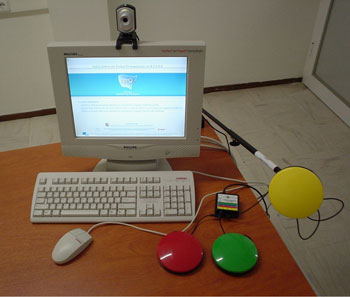
This issue in pdf Subscription Archive: Next issue: July 2005 |
|
||||
ARGO: A System for Accessible Navigation in the World Wide Webby Stavroula Ntoa and Constantine Stephanidis ARGO is a system for accessible navigation in the World Wide Web, which addresses the requirements of diverse target user groups, including people with disabilities. ARGO supports visual and non-visual interaction in order to satisfy the requirements of blind users, users with vision problems, and users with mobility impairments of the upper limbs. ARGO has been developed by ICS-FORTH in the context of the EQUAL PROKLISI Project. In the context of the 'Community Initiative EQUAL' of the European Commission, the Project PROKLISI - 'Identifying and combating simple and multiple discrimination faced by people with disabilities in the labour market', coordinated by the Hellenic National Confederation of People with Disabilities, aims to identify and combat the difficulties that people with disabilities and their families face in accessing and remaining in the labour market. One of the goals of the PROKLISI project is to exploit the potential that new technologies provide in order to develop innovative systems and tools aimed at ensuring access to information and communication to groups that are usually discriminated in the employment market.
Under this perspective, a system for accessible navigation in the World Wide Web has been developed, called ARGO, which addresses the requirements of diverse target user groups, including people with disabilities. The system supports visual and non-visual interaction in order to satisfy the requirements of:
The ARGO system operates on Microsoft Windows XP, supports all typical functionalities of a browser application, and additionally includes:
In order to address the needs of the various target user groups, ARGO employs different operation modes (visual and non-visual interaction), as well as alternative input and output devices. The system operates in three different modes:
In non-visual interaction, user input is provided through the keyboard, while the system output is provided through the use of synthetic speech and, when necessary, warning sounds. All visual interface elements are organised in a non-visual hierarchical tree structure. By using the appropriate keyboard input commands, the user can navigate in the hierarchy and interact with the currently active interface element. In visual interaction with scanning, the user provides input through three switches and receives the system output through the screen. All the interactive interface elements of the application are automatically scanned (highlighted), providing the user with the opportunity to interact with each one of them. Thus, there is only one active interface element for each dialogue step, indicated by a coloured border that highlights it. The user may interact with the indicated element, or move the scanning dialogue to the next interactive interface element, by pressing the appropriate switch. Users with less severe impairments, such as low vision or limited dexterity, can also be assisted by the system, by using the simple visual interface of ARGO in combination with the accessibility features of the operating system (eg, magnifier, mouse keys, sticky keys, etc). Evaluations with usability experts and users that took place in the usability laboratory of ICS-FORTH indicated that the system is usable and can be useful to people with disability. According to the project requirements, the ARGO system has been designed in order to operate as an information point in public places. Therefore, specifications have been provided regarding the setting of the information system and the arrangement of the assistive devices for full accessibility. To facilitate blind users in locating the system and learning how to use it without any assistance, a camera is attached to the system, and when motion is detected, instructions of use are announced. The ARGO system is currently installed and in use in two information kiosks in the municipalities of Cholargos (Attiki district) and Neapoli (Thessaloniki district). Future work includes evaluating ARGO with real users in the municipalities where it is currently available, and improving the system according to the evaluation results. Please contact: |
||||


